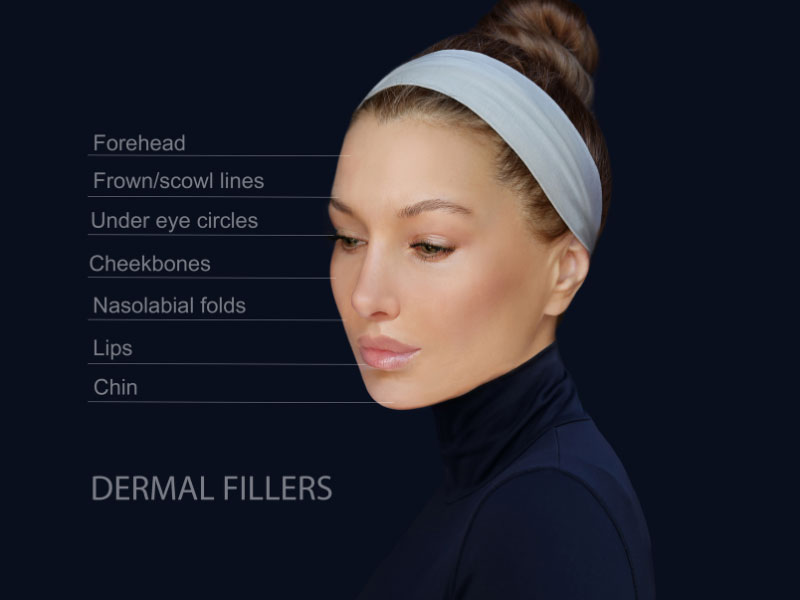What are Dermal Fillers?

Regarding cosmetic enhancements, dermal fillers offer a unique and customizable solution for cosmetic use. The application of these injectable treatments is non-invasive, with no cutting of the skin necessary. Depending on your unique concerns and goals, you can create beautiful and natural-looking results with minimal downtime.
Dermal fillers are great for tackling common aesthetic issues such as reducing the appearance of fine lines and wrinkles, restoring facial volume and contours, enhancing facial features like the lips or cheeks, and correcting uneven skin texture or sagging skin. Dermal fillers can be used for facial reconstruction and corrective treatments for scarring and other skin concerns. In the hands of the best Orlando dentist, you can trust that you will get the highest quality and most reliable results from your treatments.
You've found the best spot to learn more about how dermal fillers may enhance your appearance. Read on for more information on the uses of dermal fillers and why they are an increasingly popular treatment option.
What are dermal fillers?
Dermal fillers, which are substances injected beneath the skin, can minimize wrinkles, fine lines, and other aesthetic imperfections. They are commonly used on the face, lips, cheeks, and eyes to create a smoother, more even complexion.
Chemically, dermal fillers are made of hyaluronic acid, a natural substance found in the skin that helps to add volume and hydration. When injected into the skin, hyaluronic acid plumps up the skin and makes it look more youthful and vibrant. The main benefit of dermal fillers is the instant facial enhancement they offer patients without surgery. It is easy to understand why more individuals choose dermal fillers over facelifts because they are safer and have fewer dangers.
What do dermal fillers do?
Dermal fillers reduce the appearance of wrinkles, lines, and folds on the face, but there are more things they do. They can increase the tensile strength of skin layers and add volume to void areas on the skin too. Generally, the results of dermal fillers can range from subtle to dramatic, depending on the amount of filler used and the patient's individual goals. Dermal fillers can minimize dark circles and reduce facial wrinkles for small volumes. Meanwhile, in large volumes, dermal fillers can provide aesthetic enhancements.
Also, dermal fillers can act as a preventative measure against aging by helping to maintain collagen levels in the skin. As we age, our body produces less collagen, leading to wrinkles, lines, and other signs of aging. Dermal fillers help to boost collagen production in the skin and make it look fuller, smoother, and younger.
What kinds of dermal fillers are there?
Dermal fillers are divided into two main categories: temporary and permanent. Hyaluronic, a chemical that naturally occurs in the body and helps keep skin moisturized and plump, is the main ingredient in temporary dermal fillers. Plus, these types of fillers last anywhere from 6 months to 1 year. Some popular temporary dermal fillers include Juvederm, Restylane, and Belotero Balance.
On the other hand, permanent dermal fillers are made of polymers or synthetic materials and are designed to last several years. The most popular permanent dermal fillers include Artefill, Radiesse, Sculptra, and Bellafill. In addition, some combination products are available that contain hyaluronic acid and other ingredients, such as collagen or vitamins, that can help improve the skin's appearance and texture.
How long do dermal fillers last?
Dermal fillers can last anywhere from 6 months to 2 years, depending on the type of filler used and the area of the face being treated. For example, hyaluronic acid fillers last 9-12 months before needing a touch-up. On the other hand, Radiesse fillers typically last longer than different types and can last between 12-24 months.
The longevity of the filler results depends on several factors, such as the type of filler used, the area treated, the patient's age, lifestyle, and skin condition. The durability of dermal fillers can be impacted by lifestyle choices, including consuming alcohol, smoking, and being in the sun. Additionally, collagen production decreases as we age, so older patients may need more frequent touch-ups to maintain their desired results.
An excellent way to make your dermal fillers last longer is to follow your dentist in downtown Orlando's instructions and use sunscreen when outdoors. Follow up with your dermatologist for regular check-ups to ensure the best results. If you notice your dermal fillers starting to fade earlier than expected, you can always come in for a touch-up or switch to a different type of filler that might suit your needs.
Are there any side effects of dermal fillers?
Dermal fillers can be used to help create a more youthful appearance, reduce the appearance of wrinkles, and provide volume to facial features. However, like any medical procedure, potential side effects should be considered before treatment.
Redness and swelling at the injection site are the most frequent dermal filler adverse effects. These symptoms typically resolve within a few hours or days but may last longer, depending on the type of filler used. Other side effects include bruising, tenderness, and itching at the injection site. A less common but more severe side effect is an allergic reaction to the filler material. Sometimes, these reactions can be painful and require immediate medical attention. An allergic response may cause a rash, hives, breathing problems, or dizziness. If you experience these symptoms after having dermal fillers, seek medical attention immediately.
How can I find a good dermatologist, plastic surgeon, or dentist to perform my procedure?
Finding the right doctor for any medical procedure is essential, and dermal fillers are no exception. Before booking a consultation with a doctor or dentist, there are some critical factors to consider.
Cross-check the doctor's credentials.
It would help if you always researched the doctor's credentials and experience. Ensure the doctor or dentist is certified by the relevant medical boards and has a good reputation among previous patients. You should also ask if anyone you know has had dermal filler injections and can recommend a specific doctor they were happy with.
Book a consultation.
Once you've found a few suitable options of doctors or dentists to pick from, the next step is to book a consultation. Discuss any questions or concerns about the procedure during the consultation, such as potential risks and side effects, cost, and recovery time. You should also inquire about their preferred type of dermal filler, which will depend on the areas being treated and your desired outcome.
Finally, trusting your gut is essential when deciding on a doctor or dentist for your procedure. You should feel comfortable with the doctor's experience, approach, and overall demeanor to rest assured knowing you are in good hands. By researching and doing your due diligence in finding the right practitioner, you can ensure you have the best experience with dermal fillers.
Conclusion
Dermal fillers, a growing increasingly popular cosmetic surgery, may give volume to some areas of the face while minimizing the appearance of wrinkles and fine lines. The procedure is generally quick, minimally invasive, and has minimal side effects. With various dermal fillers available, discussing your options with a qualified practitioner is essential before deciding.
Though dermal fillers can be expensive, their effects can last months or years, depending on the type used. Dermal fillers are a secure and efficient approach to giving the face a more youthful appearance. Contact our specialists at Fine Dentistry of Downtown Orlando to see how we can help you gain confidence in your appearance.





Please login to publish a comment.
Comments (0)